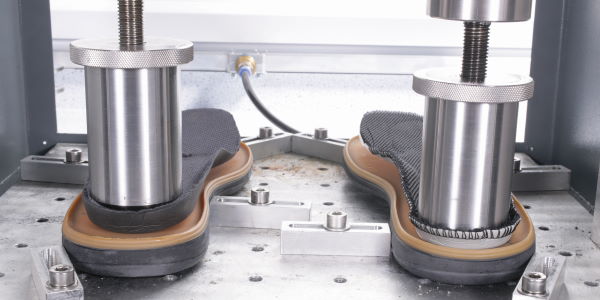Testing repeated compression in footwear
Explaining how the SATRA STM 512 machine is used in the physical testing laboratory.

A two-station unit, the SATRA STM 512 repeated compression tester simulates the forces applied by repeated heel strikes in walking. The machine can test whole shoe constructions or heel components, as well as evaluating sheet materials for midsole use.

The SATRA STM 512 repeated compression tester
The load is applied with a pneumatic plunger via a domed striker to represent the human heel. A standard test is run for 500,000 cycles and the applied load can be varied to replicate the forces attributed to men, women or children. In addition, the strike rate can be increased to accommodate accelerated testing or the assessment of running shoes.
When using SATRA STM 512, evaluation of footwear can be in the form of failure due to collapse or splitting. Another characteristic that can become evident when it is tested on this machine is the ‘compression set’ of the footwear material. Compression set is the permanent loss of thickness of a material or component which is measured after a period of recovery following the cyclic compression evaluation.

The applied load can be varied to replicate the forces that are attributed to men, women or children
The SATRA STM 512 machine can be used to help identify suitable materials for use in the construction of footwear. It can also be utilised in conjunction with other SATRA test machines to produce ageing prior to additional tests being undertaken – for example, shock absorption assessments as conducted using SATRA’s STM 479 equipment.
How can we help?
Please email test.equipment@satra.com for further information on the SATRA STM 512 repeated compression tester and to purchase these items, and visit www.satra.com/test_equipment for an overview of SATRA’s extensive range of test equipment.
Publishing Data
This article was originally published on page 22 of the February 2023 issue of SATRA Bulletin.
Other articles from this issue »


 EN
EN ZH
ZH